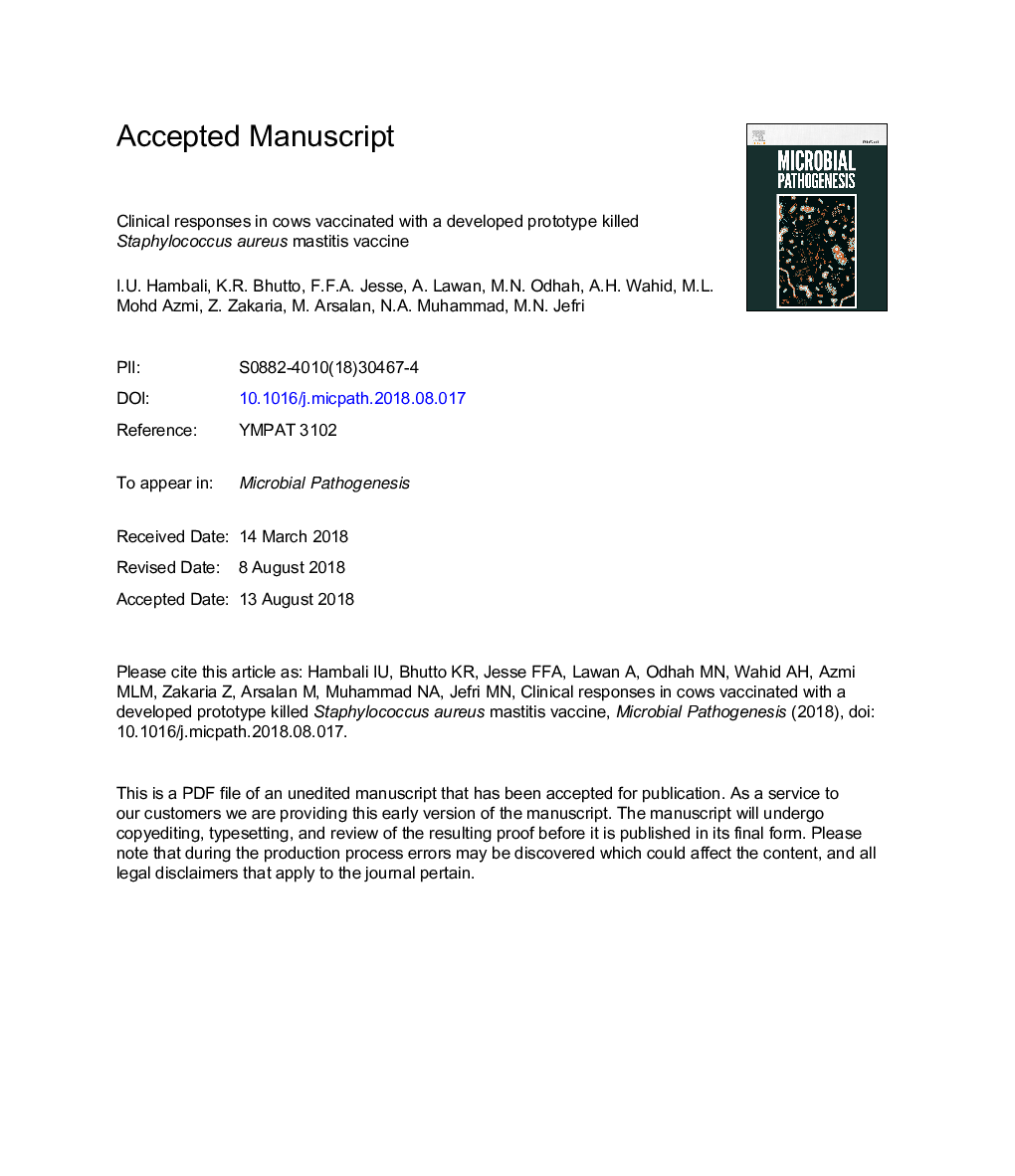| کد مقاله | کد نشریه | سال انتشار | مقاله انگلیسی | نسخه تمام متن |
|---|---|---|---|---|
| 8944999 | 1645266 | 2018 | 13 صفحه PDF | دانلود رایگان |
عنوان انگلیسی مقاله ISI
Clinical responses in cows vaccinated with a developed prototype killed Staphylococcus aureus mastitis vaccine
ترجمه فارسی عنوان
واکنش های بالینی در گاوهای واکسینه شده با یک نمونه اولیه توسعه یافته واکسن استافیلوکوک اورئوس
دانلود مقاله + سفارش ترجمه
دانلود مقاله ISI انگلیسی
رایگان برای ایرانیان
کلمات کلیدی
موضوعات مرتبط
علوم زیستی و بیوفناوری
ایمنی شناسی و میکروب شناسی
میکروب شناسی
چکیده انگلیسی
Mastitis is an inflammatory condition of the udder that occurs as a result of the release of leucocytes into the udder in a response to bacterial invasion. The major causes of mastitis are an array of gram positive and negative bacteria, however, algae, virus, fungi, mechanical or thermal injury to the gland have also been identified as possible causes. Mastitis vaccines are yet to be developed using Malaysian local isolate of bacteria. The objective of the present experimental trial was to develop a monovalent vaccine against mastitis using S. aureus of Malaysian isolate and to evaluate the clinical responses such as temperature, respiratory rates and heart rates in vaccinated cows. S. aureus is a major causative bacteria in clinical and subclinical types of mastitis in cows. Four concentrations of the bacterin (106, 107, 108 and 109â¯cfu/ml of the local isolate of S. aureus) were prepared using Aluminium potassium sulfate adjuvant. Thirty cows were grouped into four treatment groups (B, C, D and E) with a fifth group as control (A). These groups were vaccinated intramuscularly(IM) with the prepared monovalent vaccine and its influence on the vital signs were intermittently measured. The mean of rectal temperature was significantly different (pË 0.05) at 0hr Post Vaccination [1]" in groups D and E (39.5â¯Â±â¯0.15â¯Â°C and 39.4â¯Â±â¯0.15â¯Â°C respectively) and at 3â¯hâ¯PV in groups C, D and E (39.8â¯Â±â¯0.14â¯Â°C, 39.9â¯Â±â¯0.14â¯Â°C and 40.3â¯Â±â¯0.14â¯Â°C respectively) compared to the control group. This indicated a sharp increased rectal temperatures between 0hr and 3â¯hâ¯PV in groups C, D and E which later declined at 24â¯hâ¯PV. The mean of rectal temperature of group E was significantly different (pË 0.05) at weeks 1 and 2â¯PV (39.87â¯Â±â¯0.19â¯Â°C and 39.80â¯Â±â¯0.18â¯Â°C respectively) compared to the control group. The mean of heart rate was significantly different (pË 0.05) at week 1â¯PV in groups D and E (83.0â¯Â±â¯3.8 beats/minute and 80.0â¯Â±â¯3.8â¯Â°C respectively) compared to control. A trending decrease was however observed in heart rates of group E from weeks through 4â¯PV and in group D from weeks 1 through 3â¯PV. The mean of respiratory rates was significantly different (pË 0.05) at week 3â¯PV in group B and D (31.0â¯Â±â¯1.2 breaths/minute and 28.0â¯Â±â¯1.2 breaths/minute) compared to control. In conclusion, this study highlights responses of these vital signs due to vaccination against S. aureus causing mastitis in cows. To the best of our knowledge the findings of this study adds value to the shallow literature on vital signs alterations in cows vaccinated against mastitis as elevated levels of temperature and heart rates of group D and E indicated obvious response.
ناشر
Database: Elsevier - ScienceDirect (ساینس دایرکت)
Journal: Microbial Pathogenesis - Volume 124, November 2018, Pages 101-105
Journal: Microbial Pathogenesis - Volume 124, November 2018, Pages 101-105
نویسندگان
I.U. Hambali, K.R. Bhutto, F.F.A. Jesse, A. Lawan, M.N. Odhah, A.H. Wahid, M.L. Mohd Azmi, Z. Zakaria, M. Arsalan, N.A. Muhammad, M.N. Jefri,
